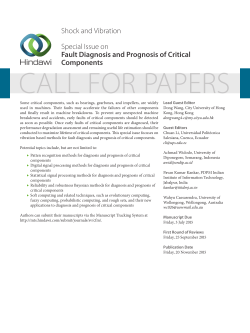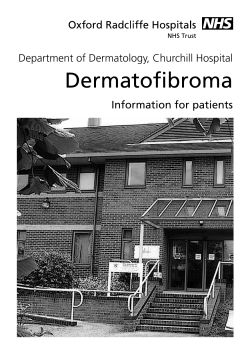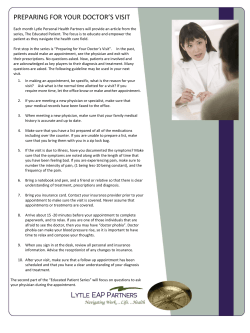
Organization theory in group practice
PRACTICE ORGANIZATION Organization theory in group practice J. D. GRENE, M.R.C.S., L.R.C.P. Warwick ORGANIZATION theory has many principles which could be considered and applied to group practice'. The transfer of basic principles from one discipline to another is often the starting point for a new look at a subject or even an advance in that subject.2 3 The more general and basic the principle, the greater its usefulness in the new subject. This is why mathematical principles can be so widely transferred. Educationalists have studied the effect of such transfers on the improvement of learning of various subjects. This research started when many people had to be taught new skills in World War II. Now is the time to take a new look at that part of medical education dealing with vocational training in general practice. The Royal Commission4 has placed the onus of laying down the scope and methods of vocational training on the aspiring trainers, viz. ourselves. The old methods have proved unsatisfactory. Those with which we replace them must be adaptable enough to assist a doctor to retrain three times in his career.5 To find these improved methods we must go to the growing point of adaptable education, the modern business schools and the universities associated with them. The practical output of these schools, the small business efficiency clinic, is inappropriate for general practice, as the basic finance of our part of the service is unalterable. Attempts to use management consultants to advise on methods of organization of medical and ancillary staff have proved useless as they are lost without the profit criterion to guide them. However, the tools which they use, work study8 and operational research,7 are applicable and have not been exploited. Powell8 has pointed out that a service free at the time of service consumption must have some form of rationing however concealed. Operational research can at least ensure this rationing is fair.9 Jay10 has shown the similarity of political and business systems. Much of what he says can be applied to the organization of general practice. Even in the days of Machiavelli, from whom he draws his examples, the structure of any system was determined by its objective. Pitfalls and good points from any form of management or government can be examined in relationship to the structure of general practice. Before considering the principles of organization theory which can be transferred to general practice, it is necessary to clear away the myths with which we have grown up. The sacredness of the doctor-patient relationship has been shown by Eysenck11 to be a myth. The concept of the general practitioner providing continual personal care is diluted by Fry12 who shows that many people get by without his help. 'That patients should be visited and treated in their homes' an American teaching unit found impossible to prove or disprove. Certainly there is a dearth of factual research on this, though there are accounts of the reduction of visiting.13 That business principles do not apply to medicine because it is a vocation-an efficient general practitioner need be no less dedicated than an inefficient one. The last myth to go will be that of our own indispensa- bility. Some of the basic tenets of organization theory are: That an organization comes into being when a group of people realizes that a synergistic effect will result from the J. ROY. COLL. GEN. PRACTIT., 1969, 17, 174 ORGANIZATION THEORY IN GROUP PRACTICE 175 proposed co-operative action; that the structure of an organization is decided by the objective of that organization, and that objective, therefore, needs careful definition; that all functions and functionaries in an organization have to be judged by their contribution to the organization's object. That the objectives of an organization may vary from time to time, but that all in the organization should be aware of the objective at any one time. Every organization irrespective of its object can be regarded as a decision making system. Each decision furthers the objective of the organization. Each person's job can be described in terms of the decisions they make and their effect on the whole process. Decisions are based on information which is of many kinds. It may originate from outside or inside the system, refer to past or future, be oral or documentary, be recurring or not, call for action or not. All these different kinds of information need different handling. Drudgery in information handling can be overcome by automation. The objective of general practice is early diagnosis.14 Prognosis and treatment follow automatically when the diagnosis is right. The rapidity and accuracy of the diagnosis are both important. The process is initiated by the patient presenting a complaint. Mass screening has not yet been proven to be the primary means of uncovering disease.15 The nature of the diagnosis in general practice is different from the pathological diagnosis of the hospital service. It may only be a label indicating disposal or it may be an elaborate social diagnosis. Subsidiary objectives can lead to better diagnosis. These include allocation of incoming requests for service by consultation or visit to match the available resources; identification of the patients and production of previous records; recording of diagnoses made and checking their final accuracy to improve the standard; referral to specialist unit for further evidence in the way of opinion. To keep the organization viable the logistics of staff pay and comfort have high priority. All objectives other than diagnosis, such as prevention of disease, are subsidiary, are better done by others, and are only incidentally achieved. Once the objective of an organization is decided, the aim is to achieve this with minimum effort. Thus the object of general practice can be described as the maximum flow of correct diagnoses with the minimum effort. Every aid to this end should be employed, such as do-it-your-self laboratory tests, eventually computer interpretation of ECGS. Open access to diagnostic aids is a sine qua non of any general practice. Once the objective of an organization is decided a specification can be written for each job showing how it contributes to the main aim. Drury hasl6 written the specification for the ideal secretary receptionist. Those parts of her job directed to diagnosis should take precedence over her many other jobs, e.g. allocating time for each patient, identifying them, producing the correct records. She is able to further public relationships by explaining everything in terms of "being done to find out what's wrong with you". The nursing sister who can get the 'emergency' patient undressed, temperature, pulse and blood pressure recorded, ready for quick inspection by the doctor is more valuable in general practice than one who is skilled in treatment. Similarly the jobs of secretary, doctor and health visitor must be specified with diagnosis as the aim. The detailed specification of each job enables each person to measure his output towards the object of the organization. This enables a target to be self set by each member of the organization after open discussion at which everyone is asked to voice an opinion. A self-set target is more likely to be reached than one set by the organization. Targets which are measurable can be compared with work done by other organizations. Having set a target for his own job in the organization each individual is able to J. D. GRENE 176 evaluate his work each year and reveal the areas in which he falls short of the target. This evaluation in industry is done by -someone of similar rank. The American tissue committees are the only value-analysis of this kind so far done in medicine. The evaluation teaches each person to be more accurate in setting next year's target. There is no reason why this evaluation should not spread to all ranks of group practice. The area of deficiency indicates that particular individual's need for further training to enable him to reach the objective of the organization. At the moment the only members of the group well catered for are the doctors who are well provided with refresher courses in every aspect of practice. They could well consider including training in subjects not normally covered by refreshers, such as management. Whatever training is arranged whether for ancillary or doctor should be in the time and at the expense of the organization which it is to benefit. To enable the organization to see its importance or unimportance the total output of work must be related to that of other organizations. Group practice should be related locally to the work of the hospital service and local authority, and nationally to surveys of work in other group practices. While accepting responsibility for early diagnosis and improving this constantly, we should insist that other branches of the service do their share and not fail to shout when we are impeded by slow communication or action. Summary and recommendations Principles from organization theory can be transferred to group practice. The time is opportune, as we need a new look at vocational training. We should use the tools of business efficiency and look at their underlying theory, realizing the basic similarity of all organizations. The object of group practice is taken as early diagnosis. Group practice is seen working as a decision-making system based on information from many sources; all jobs in the group are defined and geared towards this objective. A system of self target-setting and evaluation of performance can be used to indicate areas where in-service training is needed. Group practice should be looked at anew and compared with other organizations. The objective of the group practice should be more carefully defined and its structure geared to whatever objective is chosen. REFERENCES 1. 2. 3. 4. 5. 6. 7. 8. 9. 10. 11. 12. 13. 14. 15. 16. Haire, M. (Ed.) (1962). Organization theory in industrial practice. London. J. Wiley. de Bono, Edward (1967). The use oflateral thinking. London. J. Cape. Morris, Desmond (1967). The naked ape. London. J. Cape. Royal Commission on Medical Education (1965-68). Cmnd. 3569. London. Her Majesty's Staionery Office. Bagrit, Leon (1965). The age of automation. Reith lecture 1964. London. Pelican. Currie, R. M. (1961). Work study. London. Pitman Medical Publishing Co. McClachan, G. (Ed.) (1964). Problems andprogress in medical care. London. Oxford University Press. Revans-The morale and effectiveness of general hospitals. Powell, J. Enoch (1966). A new look at medicine andpolitics. London. Pitman Medical Publishing Co. Forsyth, G. (1963). Med. Care, 1, 10. Jay, R. (1967). Machiavelliand management. London. Hodder and Stoughton. Eysenck, H J. and Rachman, S. (1965). The causes and cures of neurosis. London. Routledge & Kegan Paul. Fry, John (1966). Profiles of disease. Edinburgh and London. E. & S. Livingstone Ltd. Marsh, G. N. (1968). Brit. med. J. 1, 633. McWhinney, I. R. (1964). The early signs of illness. London. Pitman Medical Publishing Co. Clark, E. M. (1968). J. roy. Coll. gen. Practit. 15, 69, 261. Drury, M. (1965). The medical secretary's handbook. London. Bailliere, Tindall and Cassell.
© Copyright 2025















